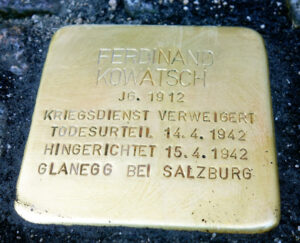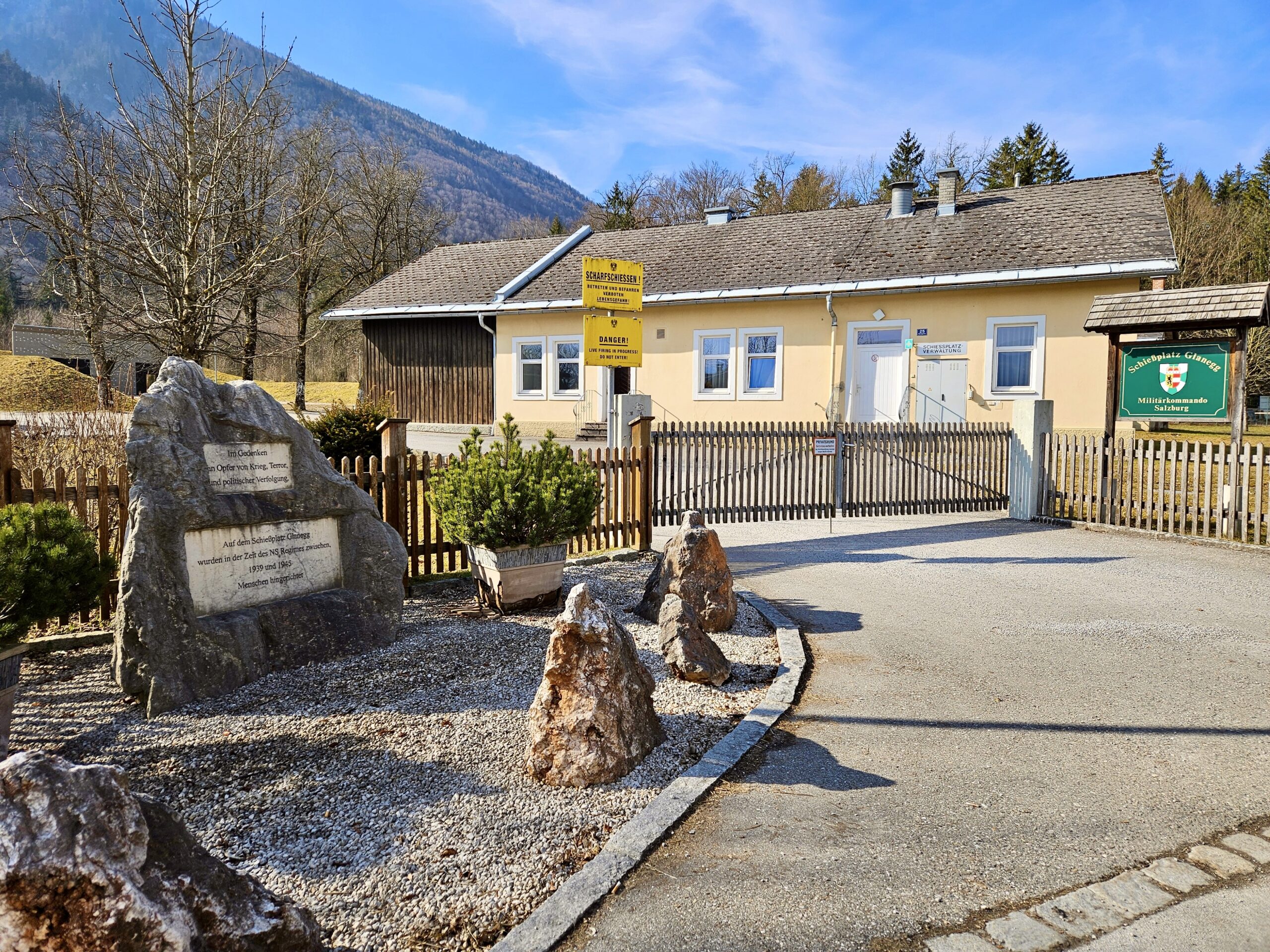Ferdinand KOWATSCH was born in Graz Austria on February 12, 1912 and was baptized Catholic. At 5:30 am on April 15, 1942 he was shot to death on the army shooting range in Glanegg, 9 km south of Salzburg.
The basic information about his 30 year long life, one that ended violently under the Nazi regime, is limited to dry facts.
Research indicates that this Styria born Austrian had a Slovenian mother (which is not surprising given the large Slovenian minority in southern Styria at the time) and that he married a woman from Carinthia (also known for having a large Slovenian minority, though it isn’t known if she was herself of Slovenian ethnicity or ancestry).
He and his wife lived in Judenburg, Styria and he worked as a carpenter until he was drafted into the German army. His military experiences remain unclear, but they moved or encouraged him to refuse to serve and desert.
In any case we know that he was tried in Salzburg, headquarters of Military Command XVIII, and that his wife had moved to Salzburg in April 1942 to be close to her husband, to be able to visit him and to give him moral support. But Ferdinand KOWATSCH was sentenced to death for desertion by a court martial of the 188th Division and was not pardoned as they hoped.
During the Second World War the courts martial of the 188th and 418th Divisions were housed in the building of the Salzburg State Court on the Rudolfsplatz (which, during the Nazi years was named after the prominent Austrian German-nationalist ideologue and Antisemite Georg von Schönerer).
We know too that it was two Salzburg Judges, Dr. Julius Poth and Dr. Ferdinand Voggenberger, acted as military judge advocate in this case – little is known about the perpetrators here because they carefully eliminated their traces.
That is the court martial records from the State Court were either destroyed or stored elsewhere in a site now unknown. The stories of those sentenced to death by courts martial in Salzburg and executed in Glanegg or the Munich-Stadelheim prison have been largely unexplored.
The lack of court martial or victims’ compensation files means that the identities of the victims in Military District XVIII, which included Salzburg, Tirol, Vorarlberg, Carinthia, and Styria, can only be discovered when we can find specific references that can facilitate targeted research.1
The search for the graves of deserters and other terror victims is futile because they were declared dishonorable and anonymous and therefor buried in the »crypt of the forgotten«, as the area for anonymous graves in the Municipal Cemetery has been known since the liberation in 1945.
In that way the Nazi authorities, the Gestapo, and the military judicial authorities reached their goal of extinguishing all evidence of their terror and preventing their survivors from honoring their loved ones.
Then too, the new political leaders in liberated Austria showed no inclination to identify deserters from the German army as »victims in the struggle for a free and democratic Austria« – something that was politically very unpopular. And that meant that the widow of the executed deserter Ferdinand KOWATSCH, who worked as a welder in Salzburg for a while, had no claim to victims’ compensation and a pension.
It took many decades before the Austrian deserters from the German army were finally legally rehabilitated. It took until a Revocation and Rehabilitation law went into effect on December 1, 2009.
It is also worth noting that on September 30, 2011, at the initiative of Salzburg Governor Gabi Burgstaller, the military commander of Salzburg ordered that a memorial for the executed conscientious objectors and deserters be set up in Glanegg – a memorial without names because they are mostly unknown.
Ferdinand KOWATSCH is one of the Salzburg victims of the Nazis’ military justice who were declared dishonorable and anonymous who were never recorded in the Salzburg police registration files and were not included in the book Widerstand und Verfolgung in Salzburg 1934-1945 [Resistance and Persecution in Salzburg 1934-1945] published in 1991. Nor were they included in the electronic victims data base of the Documentary Archive of the Austrian Resistance (DÖW).
1 So far research has uncovered the following draft resisters and deserters sentenced to death in Salzburg and executed in Glanegg or the Munich-Stadelheim prison: Johann PICHLER and Josef WEGSCHEIDER (both Jehovah’s Witnesses), Friedrich Kowatsch, Karl REITMAIER, Walter BRAUNWIESER, Georg PRODINGER, Franz Baumgartner from Saalfelden and Georg Kößner from Goldegg. Richard Pfeiffenberger from Goldegg, who was also sentenced to death in Salzburg, died in a punishment unit.
Sources
- Salzburg city and state archives
Translation: Stan Nadel
Stumbling Stone
Laid 28.09.2017 at Salzburg, Rudolfsplatz 2


 The symbol of the Nazis' civil and military courts: A sword and scales of justice combined with the Nazi Party eagle and swastika
The symbol of the Nazis' civil and military courts: A sword and scales of justice combined with the Nazi Party eagle and swastika
 »Crypt of the forgotten«
»Crypt of the forgotten«Photo: Cemetary Administration
 Commemorative plaque at the Salzburg Provincial Court
Commemorative plaque at the Salzburg Provincial CourtPhoto: Gert Kerschbaumer

 Photo: Gert Kerschbaumer
Photo: Gert Kerschbaumer
 Memorial to the victims of the Salzburg courts martial in Glanegg (erected on 30 September 2011 on the initiative of Governor Gabi Burgstaller)
Memorial to the victims of the Salzburg courts martial in Glanegg (erected on 30 September 2011 on the initiative of Governor Gabi Burgstaller)Photo: Gert Kerschbaumer
